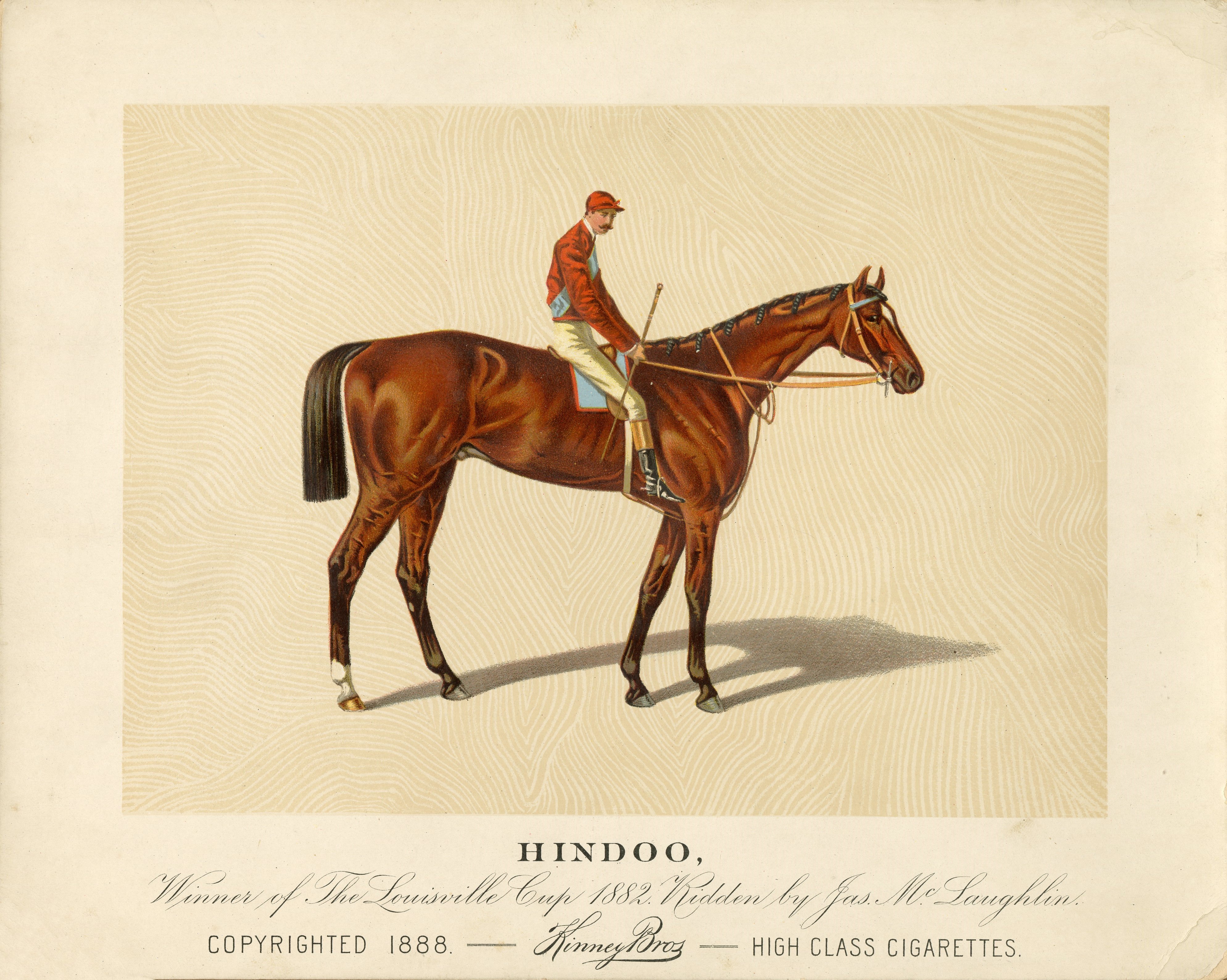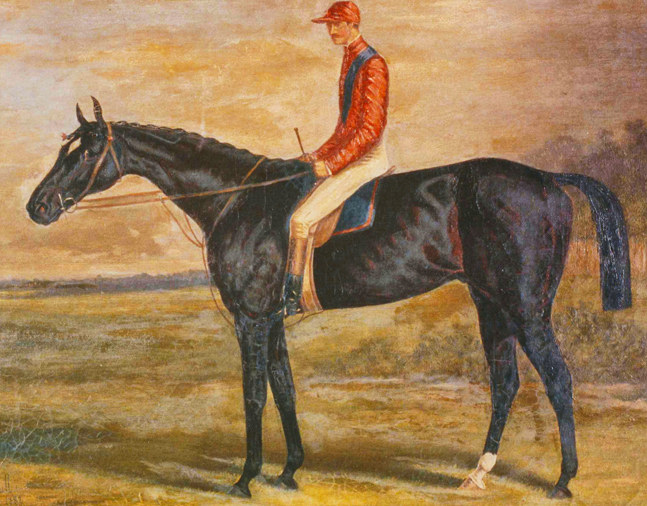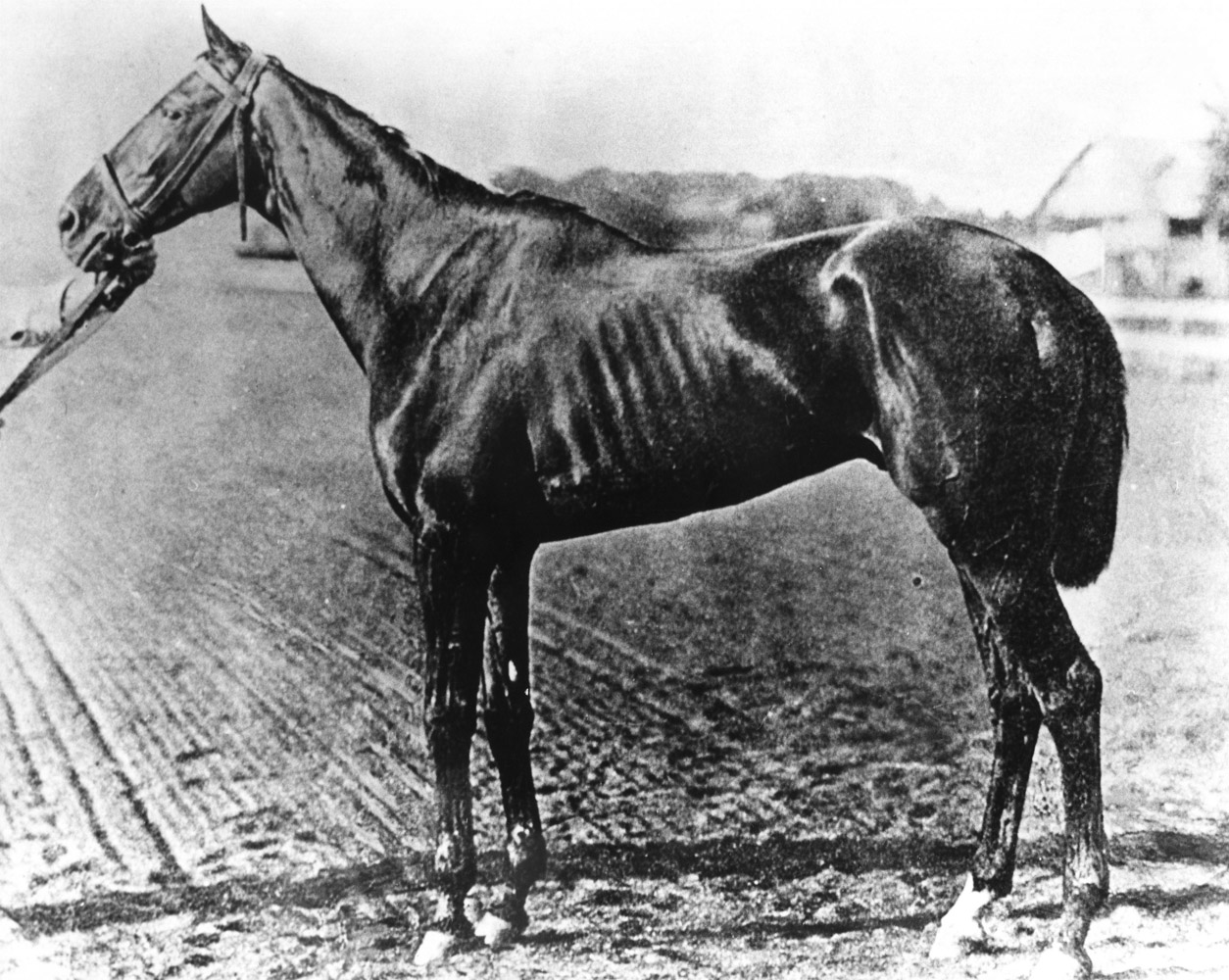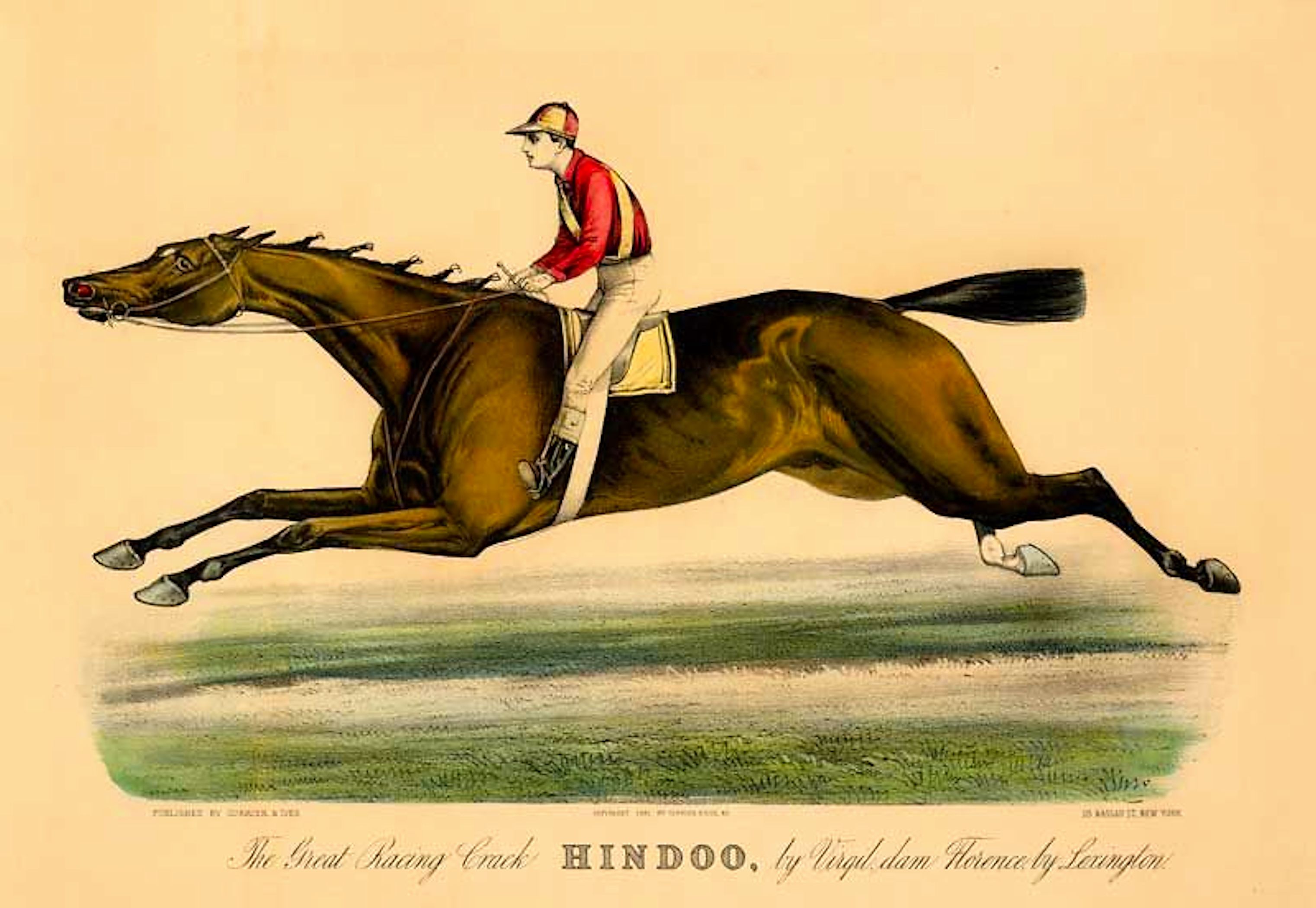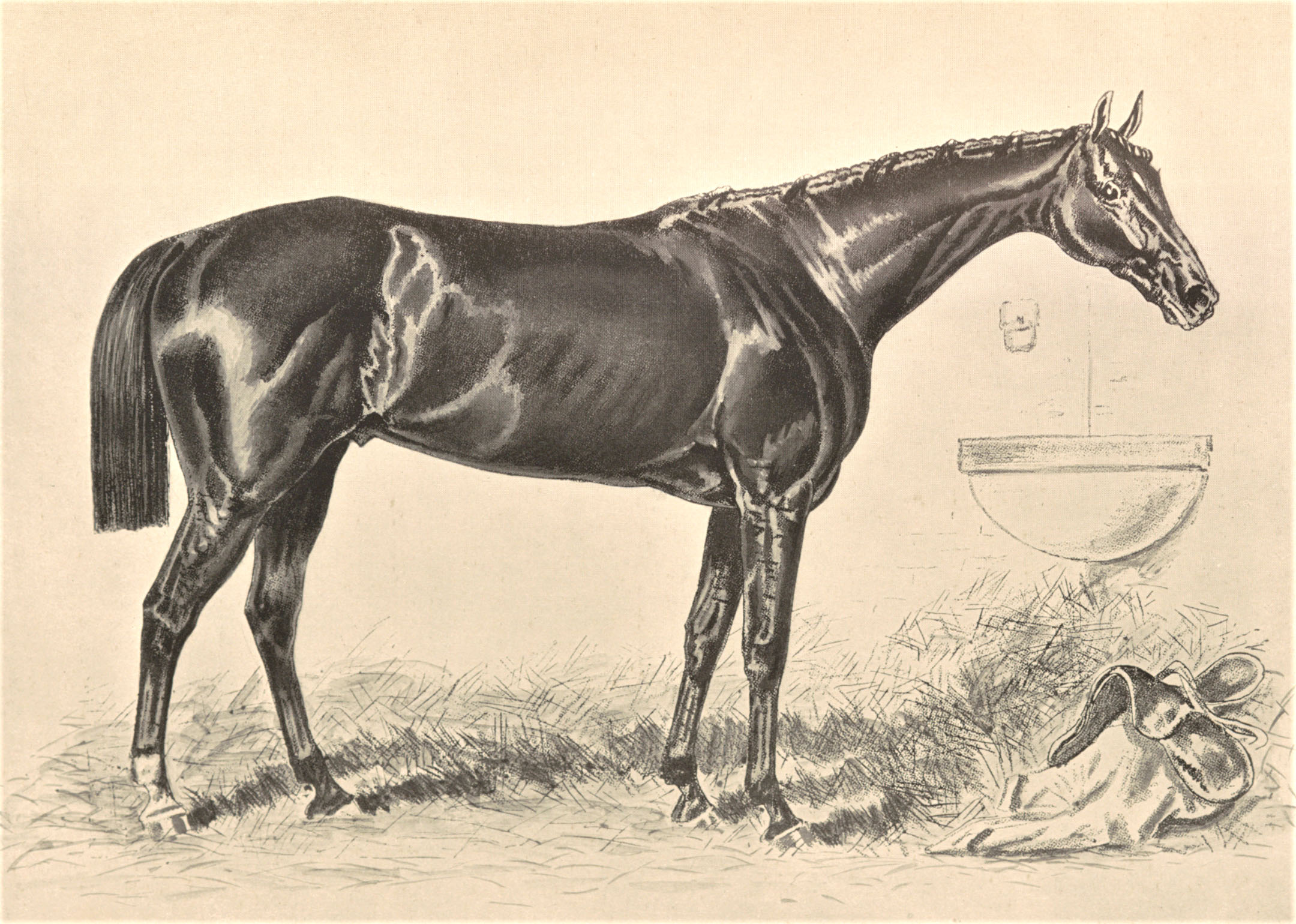Hindoo (KY)
Any conversation about the greatest racehorses of the 19th century has to include the mighty Hindoo. A bay colt by Virgil out of the Lexington mare Florence, Hindoo was bred by Daniel Swigert at Stockwell Farm in Kentucky. By the time he concluded his career in 1882, Hindoo had won 30 of 35 starts — including 18 consecutive victories during his 3-year-old season — and established a new record for career earnings at $71,875. Twenty-six of his wins were in stakes races.
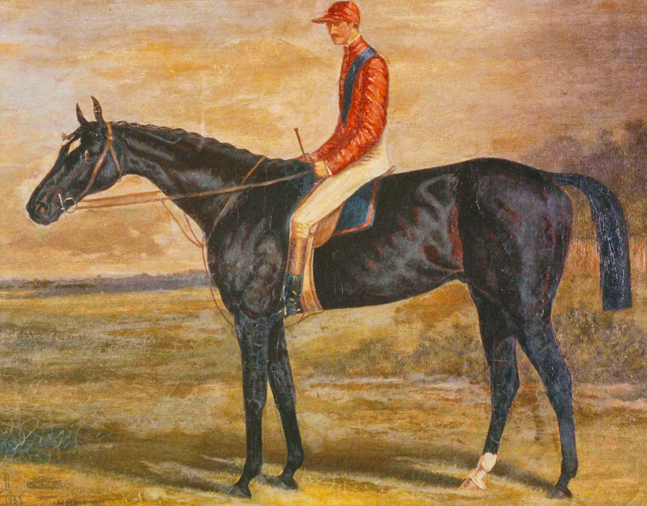
1955
1878
Virgil
Florence
Lexington
Daniel Swigert
Daniel Swigert
Dwyer Bros. Stable
Lee Paul
Edward D. Brown
James Rowe, Sr.
1880-1882
$71,785
Racing Record
35
Starts
| 1880 | 9 | 7 | 1 | 1 | $9800 $9,800 |
| 1881 | 20 | 18 | 1 | 1 | $49100 $49,100 |
| 1882 | 6 | 5 | 1 | 0 | $12975 $12,975 |
Biography
Any conversation about the greatest racehorses of the 19th century has to include the mighty Hindoo. A bay colt by Virgil out of the Lexington mare Florence, Hindoo was bred by Daniel Swigert at Stockwell Farm in Kentucky. By the time he concluded his career in 1882, Hindoo had won 30 of 35 starts — including 18 consecutive victories during his 3-year-old season — and established a new record for career earnings at $71,875. Twenty-six of his wins were in stakes races.
Hindoo made his career debut for trainer Lee Paul at the old Kentucky Association track in Lexington in May of 1880. By late June of that year, Hindoo had won his first seven starts and was so highly regarded regionally that bookmakers no longer took money on him. He had won at four different tracks in the Midwest and local competition became scarce.
In each of his first six starts, Hindoo was even money or odds-on. By his seventh start, the Tremont Hotel Stakes, Hindoo was considered such a lock he was barred from the betting. With no logical foes in the Midwest, Swigert gave Hindoo a seven-week break before sending him to Saratoga Race Course for the five-furlong Windsor Hotel Stakes.
Now in the care of Hall of Fame trainer Ed Brown, Hindoo was sent off at 1-2 in his Saratoga debut on Aug. 14, 1880. Like so many great ones before and since, Hindoo was upset at the Spa, finishing third to Crickmore. Five days later, Hindoo was once again odds-on when he finished second to the talented filly Thora in the Day Boat Line Stakes.
Hindoo did not race again that year. Although he had a record of 7-1-1 from nine starts, Hindoo’s reputation was somewhat tarnished by his Saratoga setbacks. Swigert decided to sell the colt for $15,000 to Mike and Phil Dwyer. The Dwyer brothers had the champion 3-year-old of 1880 in Luke Blackburn and were looking for another standout to go after the top sophomore prizes of the 1881 racing season.
Hindoo proved to be exactly what they were looking for.
The Dwyers turned Hindoo over to Hall of Fame trainer James Rowe, who sent him out for his 3-year-old debut on May 12, 1881, in the 1½-mile Blue Ribbon Stakes. Hindoo won easily, setting in motion one of the greatest stretches in American racing history. A week later, Hindoo won the Kentucky Derby, contested at 1½ miles, and followed with a win in the Clark Stakes. He was then shipped to Jerome Park in New York for two more wins before meeting old nemesis Crickmore in the Tidal Stakes at Sheepshead Bay.
Crickmore had won five of his six career starts at that point and was joined in the field by Belmont Stakes winner Saunterer, but Hindoo had his way, winning in a canter. The victories began to add up for Hindoo, including a 10-length romp in the Coney Island Derby and impressive scores in the Ocean Stakes and Lorillard Stakes.
Hindoo returned to Saratoga that summer and quickly made amends for his defeats at the Spa the previous year with four scintillating victories, including the 1¾-mile Travers, a race in which he was excluded from the auction pools. He added a win in the Sequel Stakes and victories over Crickmore in the United States Hotel Stakes and Kenner Stakes.
After his Saratoga dominance, Hindoo was sent to Monmouth Park in New Jersey and won the 1½-mile Champion Stakes, defeating Hall of Famer Parole and George Lorillard’s top handicapper, Monitor. At the time, Parole had recently surpassed Hall of Famer Planet’s 21-year-old record for career earnings of $69,700. Three days after the Champion, Hindoo won the Jersey St. Leger by four lengths. By Sept. 1, 1881, Hindoo had won 18 consecutive races and was the undisputed best horse in the land.
Hindoo, however, began to show wear and tear from the grueling campaign. The Dwyer brothers were known to be demanding of their horses — and Hindoo was no exception. The heavy workload caught up to Hindoo when Crickmore trounced him by 10 lengths on Sept. 7, 1881, at Sheepshead Bay in the 1¾-mile September Handicap.
Ten days later, Crickmore handed Hindoo another defeat in the Brighton Beach Purse. Hindoo conceded weight both times, but it was clear the weight of the campaign was more of a factor than the weight on Hindoo’s back. The Dwyers finally gave their great champion a break and put him away for the year.
Hindoo returned to the races as a 4-year-old on May 17, 1882, in the Dixiana Stakes at Churchill Downs. Perhaps a bit rusty, Hindoo lost his third consecutive race, as Capt. Jim Williams’ Checkmate won by a length. Hindoo returned two days later in the Louisville Cup at 2½ miles and defeated Checkmate by 1½ lengths. He met Checkmate twice more in the next two weeks, defeating him in both the Merchants’ Stakes and Turf Stakes.
The Dwyers then shipped Hindoo to New York. He won the Coney Island Stakes by six lengths on June 14 before defeating Parole and Eole in the 2¼-mile Coney Island Cup three days later. The victory in the Coney Island Cup boosted Hindoo’s career earnings to $71,875, a new American record.
Hindoo injured a tendon sheath in the Coney Island Cup and was retired with a record of 30-3-2 from 35 starts. The Dwyers had no interest in the breeding aspect of racing and sold Hindoo to Col. E. F. Clay and Col. Catesby Woodford. The Dwyers received $7,000 and a 2-year-old filly named Miss Woodford, who became America’s first $100,000 earner and eventually a member of the Hall of Fame.
Sent to Clay and Woodford’s Runnymeade Stud near Paris, Kentucky, Hindoo enjoyed a successful stallion career. From his first crop came future Hall of Fame member Hanover and stakes winners Hindoo Rose and Jim Gore. He later sired Preakness winner Buddhist, Latonia Derby winner Hindoocraft, Alabama winner Sallie McClelland, Hopeful winner Merry Monarch, and Dungarvan, winner of 51 races, among others.
Hindoo lived at Runnymeade until his death in 1901 at the age of 23.
Achievements
Champion 2-Year-Old Male — 1880
Horse of the Year — 1881
Champion 3-Year-Old Male — 1881
Horse of the Year — 1882
Champion Handicap Male — 1882
Triple Crown Highlights
Won the Kentucky Derby — 1881
Media
